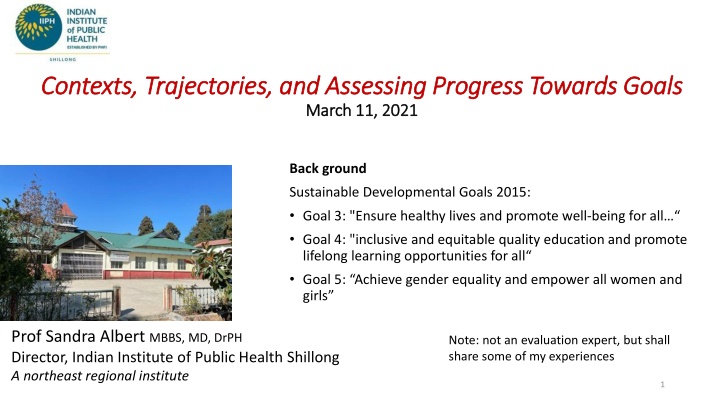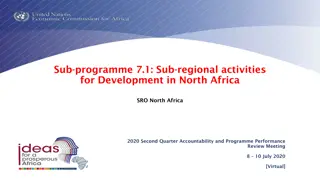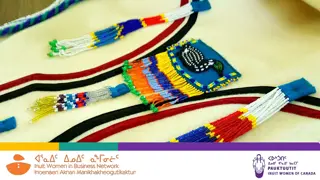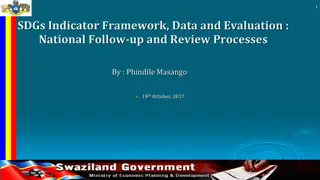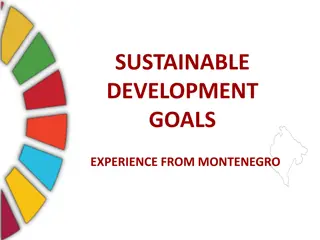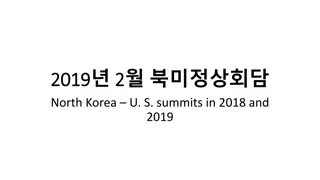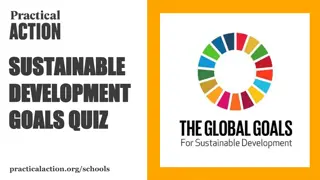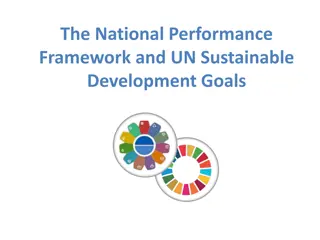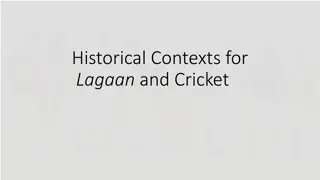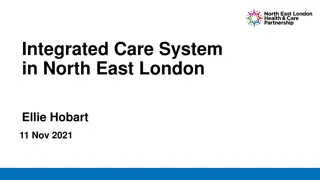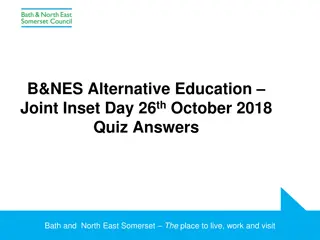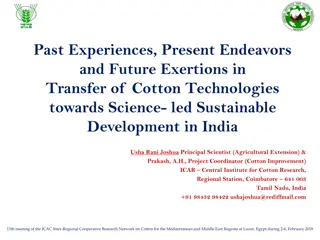Insights into Contexts and Progress Towards Sustainable Development Goals in North East India
Exploring the unique context of the North East Region of India, particularly Meghalaya, in relation to Sustainable Development Goals. Analysis of indigenous populations, societal norms, and research perspectives sheds light on challenges and progress towards achieving health, education, and gender equality objectives.
Uploaded on Oct 06, 2024 | 3 Views
Download Presentation

Please find below an Image/Link to download the presentation.
The content on the website is provided AS IS for your information and personal use only. It may not be sold, licensed, or shared on other websites without obtaining consent from the author.If you encounter any issues during the download, it is possible that the publisher has removed the file from their server.
You are allowed to download the files provided on this website for personal or commercial use, subject to the condition that they are used lawfully. All files are the property of their respective owners.
The content on the website is provided AS IS for your information and personal use only. It may not be sold, licensed, or shared on other websites without obtaining consent from the author.
E N D
Presentation Transcript
Contexts, Trajectories, and Assessing Progress Towards Goals Contexts, Trajectories, and Assessing Progress Towards Goals March 11, 2021 March 11, 2021 Back ground Sustainable Developmental Goals 2015: Goal 3: "Ensure healthy lives and promote well-being for all Goal 4: "inclusive and equitable quality education and promote lifelong learning opportunities for all Goal 5: Achieve gender equality and empower all women and girls Prof Sandra Albert MBBS, MD, DrPH Director, Indian Institute of Public Health Shillong A northeast regional institute Note: not an evaluation expert, but shall share some of my experiences 1
Context: North East Region (NER) of India Context: North East Region (NER) of India Large land mass above and beyond Bangladesh the seven sisters , hilly terrain, biodiversity hotspots Largely indigenous/ST: >200 tribes and sub-tribes Heterogeneous although the term NER contributes to a tendency to assume homogeneity Referred to as an underdeveloped region. After independence this once thriving trade belt became land locked and dependent Prior to 1947 per capita income was higher than the national average by 4% (NER Vision 2020) ~98% international borders with Bhutan, Bangladesh, Myanmar, China, Nepal
Meghalaya - the people > 3.5 million people 86% population indigenous/Scheduled Tribes: Khasi- Jaintia and Garo Tribes Khasis an ancient Austro-Asiatic migratory group - recent genetic evidence estimates Khasi- specific haplogroups evolved over 40,000 years ago (Kumar et al BMC Evolutionary Biology 2007, Reddy BM et al PLoS One 2007) Matrilineal society children are given maternal clan names women inherit ancestral property birth of daughters celebrated (unlike much of the rest of India) No caste system (unlike much of the rest of India) Sounds like a highly evolved place?
Etic-emic perspectives in research outsider insider viewpoints Skin & STI Clinician from Southern India Pilot 2008: Sexuality & Reproductive Health (SRH) workshop for UG students in a new university in Meghalaya My assumption: an evolved place such as this is unlikely to require SRH training Q. When a woman is raped the fault lies with: A. the man C. both the man & woman SRH workshops in University (2008-12): Pre-test 57% (n=631) chose B/C/D Perhaps somethings was amiss in matrilineal Meghalaya s attitude to women? War RJ, Albert S. Sexuality and Silence among Khasi Youth of Meghalaya, Northeast India. Culture, Health & Sexuality. 2013: 15 (3):S351-64 B. the woman D. sometimes the woman 4
Cluster Randomized Control Trial (cRCT): impact assessment of a novel community engagement approach for improving immunization uptake in Assam - Stimulate, Appreciate, Learn & Transfer (SALT approach) The adjusted analysis shows that the intervention had no effect on Full Immunization Coverage FIC in 12-23 month old children (OR= 0.97, 95% CI: 0.70, 1.34) Some of the results were promising, but not statistically significant But the NGOs who implemented the intervention in the field insist that a tangible difference is being observed We know behavior change takes time, so is tyranny of time one of the contributors to poor outcomes and measurement?
KAP survey on hand hygiene, respiratory etiquette and quarantine in Meghalaya (May 2020, n=416) PRACTICES BEFORE AND DURING COVID 19 Before COVID 19 During COVID 19 100% 90% 80% 70% 60% 50% 40% 30% 20% 10% 0% Going out to accomplish tasks Staying home when having flu like symptoms Avoid going to school when having flu like symptoms Covering mouth and nose when coughing/ sneezing Coughing/ sneezing into sleeves to protect others from catching illness Coughing/sneezing into sleeves when having cold Infected family member to be taken care at home instead of hospital Fairly quick behaviour change took a pandemic!
PRACTICE OF HAND HYGIENE (Before and During COVID 19) Intervals of washing hands (Before COVID 19) Intervals of washing hands (During COVID 19) >6 times/day 4-5 times/day 1-3 times/day PRACTISE OF HAND HYGIENE Occasionally Mostly Always Before feeding children After blowing nose After using the toilet Before cooking Before eating meals
High unmet need for contraception High unmet need for contraception an example form the field an example form the field Unmet need among Meghalaya women 55% (DLFHS-4, 2014) 36% NFHS-3, 21% NFHS-4 &5 Both supply and demand side factors influence unmet needs Demand side (community): the usual myths and misconceptions existed Vasectomy figures in Meghalaya: 0.1% (DLFHS-4, 2014), 0% NFHS-3, 0% NFHS-4, 0% NFHS-5 Study findings (FGD): several men said that if the alternative were for their wife to have to use an IUD, they d prefer to have a vasectomy. Men were averse to vasectomies, as they feared it would make them fat and lazy They associated it with the local practice of castrating pigs We are not sure. Nobody comes to give us information. Therefore we have to use our own brains and experiences. We have never seen a man who had a vasectomy. We would like to meet him and hear his experiences - M, 38 years, Nongmadan Mawpran Oosterhoff P, Dkhar B, Albert S. Understanding unmet contraceptive needs among rural Khasi men and women in Meghalaya. Culture, Health & Sexuality, 2015 Evaluation Q: At what point should we consider vasectomy figures to have improved here? 8
Shad suk mynsiem Kynsai & Janai 2009 The Meghalaya Paradox - roots and my journey from medicine to public health Matrilineal society (like Kerala),matrilocal, fair literacy rate, seeming decision making power for women in HH, i.e. the usual reasons cited for good health indices e.g. comparison with Kerala But poor maternal and child health indicators persist: maternal and infant mortality, prevalence of diarrhoeal diseases 10% (NFHS-5) stunting 47%, wasting 12% of under fives, IMR 32%, micronutrient deficiency in women of reproductive age, high teenage pregnancy and high fertility rates.
Context in the NER of India March 8, 2021 International Women s day, Book released by the Chief Secretary, Govt. of Meghalaya: Gender, Sexuality & Society Contextual studies of tribal communities Lead author Dr Jennifer War belongs to the Khasi Tribe (my first PhD student) Oosterhoff P, Saprii L, Kharlyngdoh D and Albert S. When the Hen Crows: Obstacles that Prevent Indigenous Women from Influencing Health-care Policies A Case Study of Shillong, Meghalaya, India. Evidence Report 119. Empowerment of women and girls. Institute of Development Studies (IDS) UK 2015. http://www.ids.ac.uk/publication/when-the-hen- crows-obstacles-that-prevent-indigenous-women... 10
Jaintia Jaintia Hills District Hills District Asia s longest sandstone cave system (BBC 2018) Nartiang forest of monoliths Pristine waterfalls e.g. Krang suri
Jaintia Hills- Meghalaya Cement industry Rat hole coal mining Unscientific sand mining and quarrying Short term developmental gains and long term .? Vision for sustainable development and its evaluation?
Thank you! Garo Hills Memang narang - Citrus indica Bird biodiversity - multiple IBAs scarlet backed flower pecker Resubelpara rock formations
